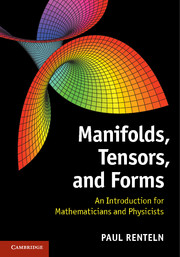Book contents
- Frontmatter
- Contents
- Preface
- 1 Linear algebra
- 2 Multilinear algebra
- 3 Differentiation on manifolds
- 4 Homotopy and de Rham cohomology
- 5 Elementary homology theory
- 6 Integration on manifolds
- 7 Vector bundles
- 8 Geometric manifolds
- 9 The degree of a smooth map
- Appendix A Mathematical background
- Appendix B The spectral theorem
- Appendix C Orientations and top-dimensional forms
- Appendix D Riemann normal coordinates
- Appendix E Holonomy of an infinitesimal loop
- Appendix F Frobenius' theorem
- Appendix G The topology of electrical circuits
- Appendix H Intrinsic and extrinsic curvature
- References
- Index
Appendix G - The topology of electrical circuits
Published online by Cambridge University Press: 05 June 2014
- Frontmatter
- Contents
- Preface
- 1 Linear algebra
- 2 Multilinear algebra
- 3 Differentiation on manifolds
- 4 Homotopy and de Rham cohomology
- 5 Elementary homology theory
- 6 Integration on manifolds
- 7 Vector bundles
- 8 Geometric manifolds
- 9 The degree of a smooth map
- Appendix A Mathematical background
- Appendix B The spectral theorem
- Appendix C Orientations and top-dimensional forms
- Appendix D Riemann normal coordinates
- Appendix E Holonomy of an infinitesimal loop
- Appendix F Frobenius' theorem
- Appendix G The topology of electrical circuits
- Appendix H Intrinsic and extrinsic curvature
- References
- Index
Summary
Kirchhoff's rules
Electrical circuits provide an example of a simple physical system in which homology and cohomology play a small but important part. We consider only the simplest case of a resistive network comprising batteries and resistors obeying Ohm's law (Figure G.1), although by employing complex impedances the theory can be extended to steady state circuits that also contain capacitors and inductors. To solve the circuit (that is, to find the currents through, and voltages across, each element) we may appeal to Kirchhoff's rules:
(1) (junction condition) the sum of the currents into a node is zero;
(2) (loop law) the sum of the voltage gains around any closed loop is zero.
The junction condition embodies the law of charge conservation, which says that you cannot create or destroy net charge. The loop law embodies the law of energy conservation (because the work W done on a charge q by a potential difference ∆V is W = q∆V, so if you the law did not hold, a charge could flow around a closed loop and gain energy ad infinitum).
A graph model
We can model such a circuit by means of a graph, which is just a bunch of points (or nodes or vertices) joined by a bunch of lines (or edges). Topologically, a graph is the same thing as a one-dimensional simplicial complex. For simplicity, we will assume that the graph has only one connected component. So, start with a connected graph G with n nodes and m edges that models the topology of the circuit. Label the nodes, then orient each edge arbitrarily.
- Type
- Chapter
- Information
- Manifolds, Tensors, and FormsAn Introduction for Mathematicians and Physicists, pp. 296 - 307Publisher: Cambridge University PressPrint publication year: 2013



